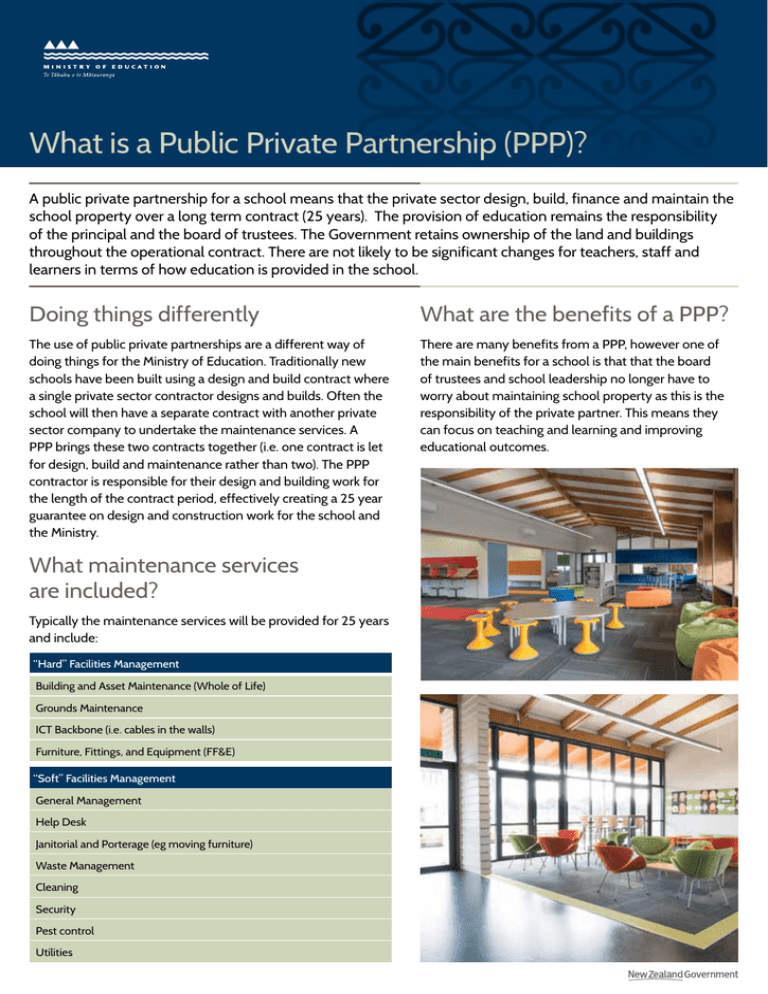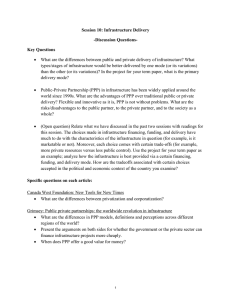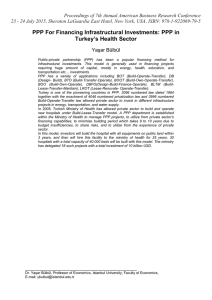What is a Public Private Partnership (PPP)?
advertisement

What is a Public Private Partnership (PPP)? A public private partnership for a school means that the private sector design, build, finance and maintain the school property over a long term contract (25 years). The provision of education remains the responsibility of the principal and the board of trustees. The Government retains ownership of the land and buildings throughout the operational contract. There are not likely to be significant changes for teachers, staff and learners in terms of how education is provided in the school. Doing things differently What are the benefits of a PPP? The use of public private partnerships are a different way of doing things for the Ministry of Education. Traditionally new schools have been built using a design and build contract where a single private sector contractor designs and builds. Often the school will then have a separate contract with another private sector company to undertake the maintenance services. A PPP brings these two contracts together (i.e. one contract is let for design, build and maintenance rather than two). The PPP contractor is responsible for their design and building work for the length of the contract period, effectively creating a 25 year guarantee on design and construction work for the school and the Ministry. There are many benefits from a PPP, however one of the main benefits for a school is that that the board of trustees and school leadership no longer have to worry about maintaining school property as this is the responsibility of the private partner. This means they can focus on teaching and learning and improving educational outcomes. What maintenance services are included? Typically the maintenance services will be provided for 25 years and include: “Hard” Facilities Management Building and Asset Maintenance (Whole of Life) Grounds Maintenance ICT Backbone (i.e. cables in the walls) Furniture, Fittings, and Equipment (FF&E) “Soft” Facilities Management General Management Help Desk Janitorial and Porterage (eg moving furniture) Waste Management Cleaning Security Pest control Utilities Key questions answered... Ownership Land and buildings are owned by the Ministry for the duration of the contract. A Property Occupancy Agreement is signed between the Ministry and the board of trustees. Control over the use of the building The board of trustees decide what the ‘core hours’ will be (i.e. the time students will be in the school). They also decide which specialist areas will be open to the school and to what time (i.e. after school use for sport, arts and cultural activities). Staff have unlimited 24/7 access to school facilities. The board of trustees are also able to access the school for other one off type meetings by arrangement with the private partner outside of the agreed hours. An example of this is parent/teacher evenings. The board of trustees make all decisions on third party use. Private sector involvement in education There will be no private sector involvement in education beyond providing the buildings that enable teaching and learning to take place. The teachers provide the teaching and all decisions on the education lie with the board of trustees and school leadership. A PPP simply offers an alternative method to procure property (not provide education). Will the private sector make a profit? Yes – however the private sector make a profit under the current procurement model from design and build contracts and project management costs through to facilities management service providers etc. PPP brings these contracts together. Board of trustees and school leadership and principals can focus on developing educational policies that enhance teaching What will board of and learning and ultimately improving educational outcomes for students. A principal from an Australian PPP school trustees and school leadership do with reduced expressed relief at no longer having to deal with property issues. role on property matters Consistency in the services provided under PPP A service specification determines the service standards that must be met – similar to any other facilities management service contract. Information and communications technology remains the responsibility of the board of trustees. Impact on design We expect that in NZ, design quality will not be significantly impacted. In fact it may improve when compared to current procurement which has in some cases led to leaky buildings. Governments can raise money at a cheaper rate than private companies Financing costs are included in the detailed analysis when deciding whether to use PPP or not. With private sector efficiency savings, our analysis showed that a PPP is marginally cheaper (better value for money) than traditional procurement for projects over a certain size. If the private partner fails This is true for any contract; however the Ministry can partly mitigate this risk through the selection process. Further under a the taxpayer will have to PPP, equity investors and the bank will seek to protect their investments through rigorous review and reporting requirements to ensure the private sector does not fail. Note: we pay for the school over a 25 year annuity – there are no upfront costs. pick up the costs Case study: Hobsonville Point schools Hobsonville Point primary and secondary schools are the first schools in NZ to be delivered under a public private partnership contract. Hobsonville Primary school will open in term 1 2013 and Hobsonville Point secondary school in term 1 2014. The primary school will accommodate a final roll of 690 students and the secondary school a final roll of 1500 students. Following a robust procurement process the Learning Infrastructure Partners consortium were awarded a contract to design, build, finance and maintain both schools for a period of 25 years. The Hobsonville Point schools are being designed to meet the needs of teaching and learning in the 21st century. Teachers and students will have a range of innovative, flexible and functional spaces to support a wide variety of teaching and learning practices. “At Hobsonville Point, we will be creating a school that allows students to become the best they can be in all areas of development through strong relationships, shared learning design and high expectations of our Daniel Birch whole community” Foundation Principal Hobsonville Point Primary School The Ministry is capturing lessons learnt from the project and will apply these lessons to any future PPPs. Questions or comments If you have any comments or questions please email nzschools.ppp@minedu.govt.nz or write to NZ Schools PPP Project, Ministry of Education, PO Box 1666, Wellington. More information on the Hobsonville Point PPP can be found on the project’s webpage http://www.minedu.govt.nz/nzschoolsPPP

